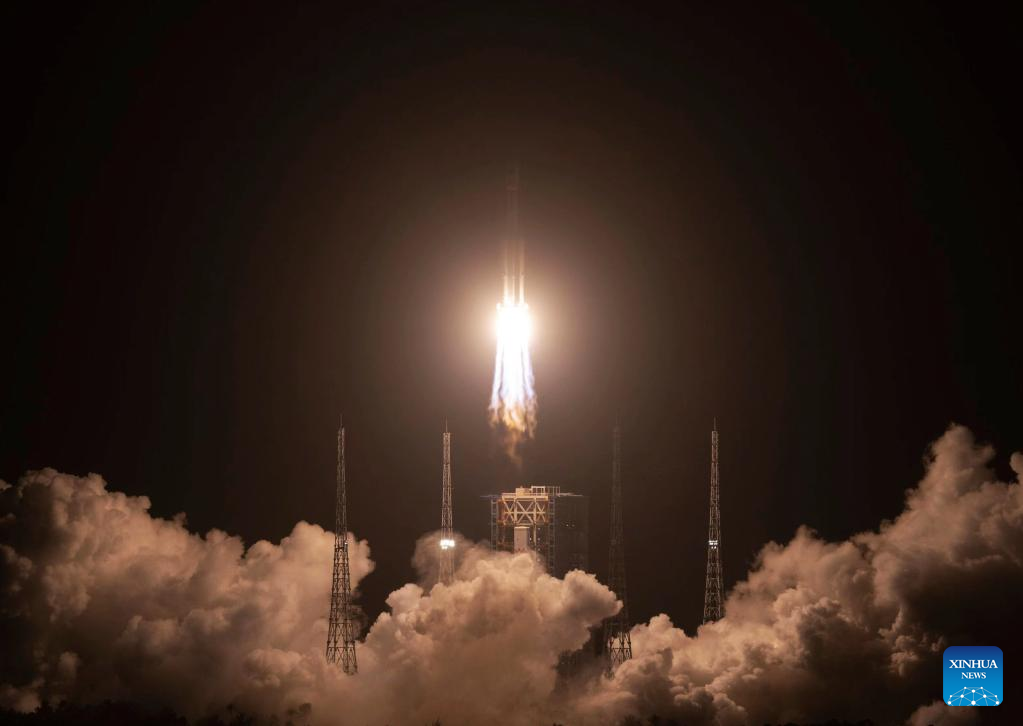
A Long March-7 Y7 rocket carrying the Tianzhou-6 cargo craft blasts off from the Wenchang Spacecraft Launch Site in south China's Hainan Province, May 10, 2023. (Xinhua/Yang Guanyu)
WENCHANG, Hainan, May 10 (Xinhua) -- China launched a new cargo mission on Wednesday night to transport supplies to its orbiting Tiangong space station, according to the China Manned Space Agency.
Carrying the Tianzhou-6 cargo craft, a Long March-7 Y7 rocket lifted off at 9:22 p.m. (Beijing Time) from the Wenchang Spacecraft Launch Site in the southern island province of Hainan, the agency said.
After around 10 minutes, Tianzhou-6 separated from the rocket and entered its designated orbit. Its solar panels soon unfolded and began working. The agency declared the launch a complete success.
The cargo vessel will later conduct an automated rendezvous and docking with the station combination in orbit.
The newly launched Tianzhou-6 has improved features compared to the previous Tianzhou craft, with a greater loading volume and a larger carrying capacity.
Wang Ran, chief designer of the Tianzhou series who works with the China Academy of Space Technology, said the effective loading volume increased from 18.1 cubic meters to 22.5 cubic meters, equivalent to a 20 percent expansion. The loading capacity has been improved to 7.4 tonnes, making Tianzhou-6 the world's largest cargo spacecraft in service.
In this mission, Tianzhou-6 is loaded with more than 200 pieces of goods, including daily supplies for taikonauts as well as clothes, food, fruit and water, with a total weight of around 5.8 tonnes.
The cargo craft has also upgraded to reduce the launch demand for cargo craft from twice a year to three times every two years, which will substantially reduce transportation costs.
The Tianzhou-6 mission is the first after China's crewed space station program entered the stage of application and development. The cargo craft is also tasked with sending multiple scientific experiment payloads to the space lab.
Liu Wei, designer of the cargo craft's application system at the Technology and Engineering Center for Space Utilization under the Chinese Academy of Sciences, said Tianzhou-6 will deliver a total of 98 experiment-related items with a weight of 714 kg, including research samples and supporting equipment. Taikonauts will transport these goods to the station modules after the cargo craft docks at the space station.
As scheduled, 29 scientific experiments and application tests will be carried out in four fields: space life science and biotechnology, fluid physics and combustion science in microgravity, material science in space, and new technology tests for space applications.
Liu said that the Wentian lab module will host studies like the microgravity environment's influence on the differentiation of stem cell lineage, the 3D growth and tissue construction of stem cells, and the molecular evolution of protein and nucleic acid's same origin.
Several tests outside the Wentian and Mengtian lab modules will be conducted for the first time, Liu added.
Tianzhou-6 is also tasked with an experiment satellite project by Dalian University of Technology. ■

A Long March-7 Y7 rocket carrying the Tianzhou-6 cargo craft blasts off from the Wenchang Spacecraft Launch Site in south China's Hainan Province, May 10, 2023. (Xinhua/Jin Liwang)

A Long March-7 Y7 rocket carrying the Tianzhou-6 cargo craft blasts off from the Wenchang Spacecraft Launch Site in south China's Hainan Province, May 10, 2023. (Xinhua/Yang Guanyu)



